
|
KIT: |
Messerschmitt 1/48 Bf-109Z |
|
KIT # |
Uses two Hasegawa 1/48 Bf-109G-2 kits |
|
PRICE: |
|
|
DECALS: |
Two versions: Generic German and Russian |
|
REVIEW & |
|
|
NOTES: |
Resin conversion via Bringuer Aviation Prod. |
ZWILLING: The Bf-109Z

|
HISTORY |
While the Bf-109K series was the last Bf-109 to see production, it was not the last to see development to prototype status. Perhaps the most intriguing variant of the basic Bf-109 actually built was the Zwilling, or "Siamese Twin" version.
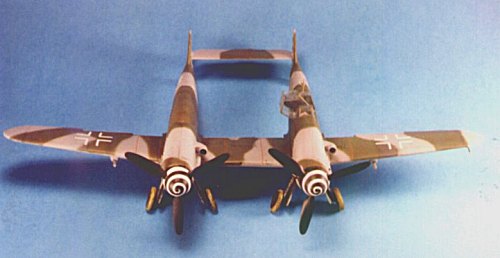 The Zwilling concept
originated with Generaloberst Ernst Udet, who - in 1940 - proposed the
marriage of two He-111 airframes to create an aircraft capable of towing the
Me-321 Gigant assault/transport glider. The success of this development
led to a study by Messerschmitt of the possibility of mating two Bf-109
airframes to create a heavy Zerstoerer, while avoiding the disruption of
production lines that would inevitably result from the introduction of an
entirely new airframe.
The Zwilling concept
originated with Generaloberst Ernst Udet, who - in 1940 - proposed the
marriage of two He-111 airframes to create an aircraft capable of towing the
Me-321 Gigant assault/transport glider. The success of this development
led to a study by Messerschmitt of the possibility of mating two Bf-109
airframes to create a heavy Zerstoerer, while avoiding the disruption of
production lines that would inevitably result from the introduction of an
entirely new airframe.
The Technischen Amt expressed interest in the proposal, since it appeared to offer a considerable advance in performance over any other current or planned Zerstoerer, while conforming to RLM policy restricting production to a small number of basic types.
Two Bf-109F airframes were allocated for the conversion, with the project commencing late in 1942. The two airframes were virtually unchanged, apart from the introduction of a keel in each airframe to carry the landing gear, which would be moved to operate from the centerline of each fuselage. The components were married by means of a parallel-chord center section carrying two radiators and gear wells, with a central strong point capable of carrying a 1,102-pound bomb, and a parallel horizontal stabilizer. The starboard fuselage had the cockpit removed and replaced by a fuel tank with a metal fairing over the position.
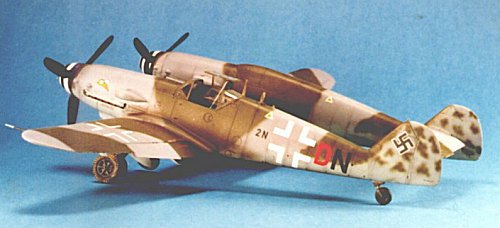 While work proceeded,
Messerschmitt continued planning, basing the production design on the Bf-109G,
with either the DB605A or Jumo 213E engine for power. Armament was projected as
two engine-mounted 30mm MK108s, two similar weapons in gondolas under the outer
wings, with a single MK103 slightly to starboard of the centerline inside the
center wing section. For the fast bomber role, a single 1,102-pound bomb would
be carried on the centerline, with a 551-pound bomb under each fuselage.
While work proceeded,
Messerschmitt continued planning, basing the production design on the Bf-109G,
with either the DB605A or Jumo 213E engine for power. Armament was projected as
two engine-mounted 30mm MK108s, two similar weapons in gondolas under the outer
wings, with a single MK103 slightly to starboard of the centerline inside the
center wing section. For the fast bomber role, a single 1,102-pound bomb would
be carried on the centerline, with a 551-pound bomb under each fuselage.
The prototype was completed in 1943. Preparation for flight trials was proceeding when the prototype was severely damaged during a bombing raid on the factory. The program was abandoned in 1944. The only fighter based on this concept that would ever fly operationally was the North American F-82 Twin Mustang.
However, for my purposes, I have presumed that the prototype did fly successfully, and that in early 1944 twelve pre-series machines, based on the Bf-109G, were ordered. These aircraft operated as the Erprobungsstaffel Zwilling, attached to II/ZG76 in the late summer and fall of 1944. This is probably as close to "Luft '46" as I will get for my personal collection.
|
THE KIT |
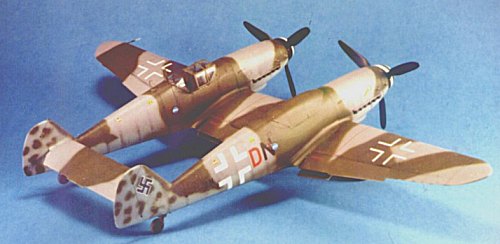 At one time or another, I
have heard nearly every modeler who builds 109s say "I sure wish I could do
a Zwilling." However, anyone with any sanity, after looking into the major
cutting and hacking and scratchbuilding involved in such a project, has usually
backed off. The only person I know of for certain who ever made such a model is
the editor of this publication, who accomplished the feat in 1/72 scale 20 years
ago; sadly, the model did not survive a move about 15 years ago and no longer
exists.
At one time or another, I
have heard nearly every modeler who builds 109s say "I sure wish I could do
a Zwilling." However, anyone with any sanity, after looking into the major
cutting and hacking and scratchbuilding involved in such a project, has usually
backed off. The only person I know of for certain who ever made such a model is
the editor of this publication, who accomplished the feat in 1/72 scale 20 years
ago; sadly, the model did not survive a move about 15 years ago and no longer
exists.
In the early 1990s, before he moved on to create Classic Airframes, Jules Bringuer made a series of resin conversion sets, most notably a C wing for the Tamiya or Hasegawa Spitfire V, and a conversion set to create the Zwilling from two Hasegawa kits. At a price of over $40 for the conversion set, and $25 each for the necessary kits, this was not an inexpensive conversion project. At the time I ran across the set in 1995, back when I was a well-paid Story Editor and the money was less than I might have spent on dinner on a given night, the Bf-109F kits were out of production. I therefore picked up two of the Bf-109G-2 kits and decided to make the "pre-production" version. Events conspired to put the project on hold for longer than expected, and it was only this past fall, four years later, that it saw fruition.
|
CONSTRUCTION |
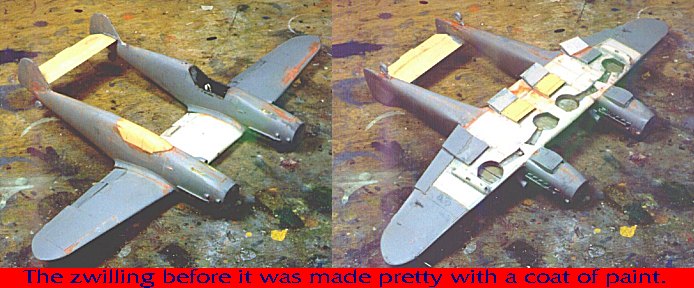
The actual construction work is fairly simple. the resin set provides the lower wing section out to midpoint of the lower wings outboard of the standard position of the landing gear, with the upper part of the center section and including radiator baths for the center section; underwing gondolas; a resin plug for the starboard cockpit; and the horizontal stabilizer. This is nice clean resin, the only trouble (for me) being that it was molded so that the radiator doors were closed and that portion of the flap in the center section was raised. I cut away the flap and radiator baths, scratchbuilt the radiator doors, and was on my way.
After the lower wings were cut away (on panel lines), the construction was straightforward, other than filling in the mounts for the machine guns on the cowlings. This was filled with cyanoacrylate glue and hit with accelerator, sanded smooth and then covered with Mr. Surfacer 500 to get a smooth surface.
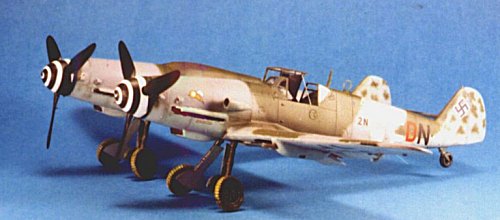 The cockpit was
assembled out of the box, and equipped with seatbelts from the new Eduard
photo-etch German seatbelts set.
The cockpit was
assembled out of the box, and equipped with seatbelts from the new Eduard
photo-etch German seatbelts set.
The outer sections of each tail section had to have the mounting areas removed for the horizontal stabilize, the area filled and sanded smooth.
Once assembly was complete, the various areas of attachment between styrene and resin were filled with Mr. Surfacer 500 to get rid of seams.
|
PAINT & DECALS |
I painted the model in a modified version of the camouflage pattern used on the Bf-109G-10, with upper surfaces RLM75 and RLM82, and RLM76 lower surfaces.
I used decals from an Aeromaster Me-410 sheet, with the wooden clog insignia of II/ZG76 and squadron codes, with standard late-war national insignia from various Bf-109 sheets in the decal dungeon.
|
CONSTRUCTION CONTINUES |
I gave some light weathering to the model, since I had determined these airplanes did not see much service prior to their phase-out in the fall of 1944 due to the overall phaseout of the Zerstoerer formations.
My only real problem was getting all four main wheels and two tail wheels to all touch a flat surface at the same time, which required some fiddling. Close examination would reveal that the tail wheels are at slightly different angles to close that final one millimeter gap.
|
CONCLUSIONS |
This is definitely a model that gets comment when seen. As it turns out, one of my collectors took one look at it and made me a financial offer I could not refuse for the privilege of becoming its new owner. However, I hear that guy in Virginia is going to make a Bf-109 Zwilling conversion to go along with his He-111 Zwilling, so perhaps a Bf-109Z will still grace my personal shelves some day for longer than this one has.
If you would like your product reviewed fairly and quickly by a site that has over 800 visits a day, please contact me or see other details in the Note to Contributors.